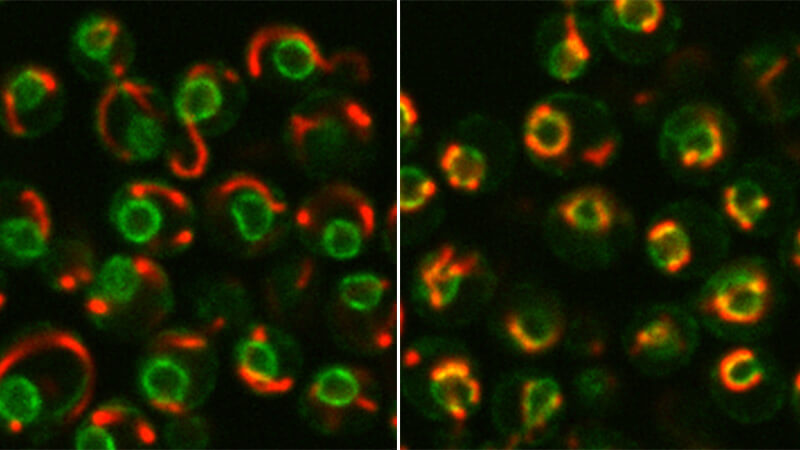The institute's scientists revealed a communication channel between two key players in the cell - the nucleus and the mitochondria - and showed that the two organelles exchange messages with each other through molecular communication lines
Like any regime, the one practiced in the cell also needs means of communication and the ability to transmit information. Recently revealed Weizmann Institute of Science scientists created a communication channel between two key players in the cell - the nucleus and the mitochondria - and showed that the two organelles exchange messages with each other through physical connection points that constitute a kind of molecular communication lines. Eavesdropping on wired communication between cell organelles is expected to allow scientists to better understand disease states that develop due to disruptions in communication channels - from cancer to degenerative diseases of the nervous system.
Safely wrapped in their lipid membrane, cell organelles need communication channels with their environment, including receiving messages from other organelles. Maintaining a continuous flow of information is especially important for the organelles of the nucleus and the mitochondria: the nucleus, where the valuable genetic code is stored, depends on the mitochondria - the powerhouses of the cell - to supply the large amount of energy required in the initial stages of gene expression. Mitochondrial organelles, for their part, depend on the storage services of the nucleus for most of their genetic programs and for their timely execution.

"The popular explanation is that the origin of mitochondria is in an ancient bacterial cell, without a nucleus of course, which was swallowed whole by another primitive single-celled life form in which a nucleus had already developed," explains Prof. Maya Schuldiner whose laboratory in the Department of Molecular Genetics at the Weizmann Institute of Science specializes in the study of intracellular communication. "Thus, genes originating from the mitochondria migrated slowly towards the cell nucleus and merged during evolution with the genome of that organism. This evolution made the existence of the communication channels between the organelles a necessity - as they enable close coordination between the amount of cellular energy available for the various cellular tasks."
One way of communication between organelles is real physical connection points made possible by means of tethering molecules. previous researches In Prof. Shuldiner's laboratory, they showed that such lines of communication can be stretched between any two organelles, but the characterization of the important communication channels between the cell nucleus and the mitochondria has so far remained elusive.
In the current study, a team led by Dr. Michal Eisenberg-Bord and PhD student Naama Tsong, began to search for these communication channels in the cells of baking yeast - a single-celled microorganism that is easy to grow and resembles human cells. Using a method previously developed in Prof. Shuldiner's laboratory by the PhD student at the time, Dr. Nadav Shai, the researchers engineered the yeast cells to express a fluorescent protein that lights up in response to creating a connection between two organelles.
After confirming the existence of the communication channels between the nucleus and the mitochondria and identifying the locations of the contact points between the organelles with the help of the fluorescent protein, the researchers set out to reveal the molecular mechanisms that enable this type of communication. To this end, they used a method called "high-throughput screening" (HTS) that allows thousands of different yeast strains to be scanned, in a relatively short time and efficiently, in search of genes and their protein products involved in this mechanism. After scanning nearly 6,000 different yeast proteins, the research team was able to identify a protein that has not yet been characterized in the scientific literature and is found abundantly at the points of contact between the organelles.
When the researchers caused yeast cells to produce an especially large amount of this protein, which was named Cnm1 - the mitochondrial organelles in the cells flocked towards the nucleus, congregated around its membrane and formed a branched array of contact points with it. "We showed that Cnm1, a protein embedded in the nuclear membrane, behaves like a 'communication wire', by binding to another known protein on the mitochondrial membrane," explains Prof. Schuldiner.
In addition to identifying the molecular components of the communication mechanism between the organelles, the researchers also successfully uncovered a control mechanism that regulates the process of creating the contact points: when the activity of various enzymes necessary for the creation of a fat molecule called phosphatidylcholine - a significant component of biological membranes - was disrupted, the amount of Cnm1 dropped , and the branched contact points that appeared in the previous experiment disappeared. "It is clear that the reason for this did not lie in the cessation of the activity of one or another enzyme, but in the fact that there was not enough of the fat molecule itself," explains Prof. Schuldiner, "and as evidence, when we added the molecule to yeast cells that had been engineered so that they could not produce on their own, the contact points returned Appear".
The discovery of the molecular mechanism that enables a two-way communication channel between the nucleus and the mitochondria lays the foundations for a deeper understanding of the functions of these organelles. This understanding is particularly significant since communication disruptions in this channel may contribute to the development of various diseases including various types of cancer, neurodegenerative diseases of the nervous system, insulin resistance that characterizes type 2 diabetes patients, morbid obesity, and in general to tissue aging.
More of the topic in Hayadan:

2 תגובות
interesting
The title "Mitochondria, answer this is me" contains a linguistic error.
"Mitochondrion, answer, it's me."
Because "mitochondrion" is a Greek word, therefore:
Mitochondrion is the form of the unit
Mitochondria is the form of reproduction